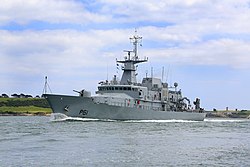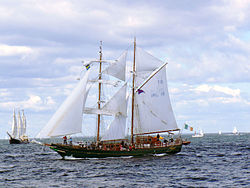| Name | Image | Type | Notes |
|---|
| SS Dainty | | Salvage tug/Patrol sloop | STOIC-class tug built in Chepstow in 1918 for the Admiralty. She had a length of 43 m (142 ft), a displacement of 476 t (468 long tons) and armed with a 12-pounder gun. Sold to French interests, renamed SS Cherbourgeois. [54] |
| PV Muirchú |  | Patrol vessel | Launched in 1908 as HMY Helga (Pendant No 064). Armed with a 12-pounder gun. Disarmed and transferred to Department of Agriculture and Fisheries for fisheries protection. |
| John Dunn (Adty No 3741) |  | Mersey-class trawler | The Mersey trawlers were a class of over 100 naval trawlers built for the Royal Navy during World War I. The trawlers were 45 m (148 ft) in length, with a displacement of 445 t (438 long tons), a crew of 15, a speed of 11 knots (20 km/h; 13 mph) and armed with a 12-pounder gun. |
| John Dutton (Adty No 3739) |
| William Honnor (Adty No 3796) |
| Robert Murray (Adty No 4256) |
| Thomas Thresher (Adty No 3572) |
| Christopher Dixon (Adty No 3563) |
| TR.24 |  | TR series trawler | The TR trawlers were a Canadian version of the Castle-class trawler built by Canadian Vickers, Montreal during World War I. The trawlers were 41 m (133 ft) in length, with a displacement of 283 t (279 long tons), a crew of 15, a speed of 10 knots (19 km/h; 12 mph) and armed with a 12-pounder gun. |
| TR.25 |
| TR.27 |
| TR.29 |
| TR.30 |
| TR.31 |
| Inishirrer (Official No. 135637) | | Drifter | Built in Arklow in 1913, she was 20 metres (65 ft) in length and was assessed at 51 gross register tons (GRT). [55] [56] Acquired from Congested Districts Board in August 1922. Armed with machine guns |
| John S Summers (Official No 125960) (Admiralty No 2147) [57] | | Built in Lowestoft in 1910, she was 23 m (77 ft) length and assessed at 62 gross register tons (GRT). [58] Was hired by Royal Navy as a net vessel during World War I. [59] Armed with machine guns |
| ML1 |  | Motor Launch | Four ELCO motor launches were acquired in May 1922 for the Marine Investigations Department. ML2 sank off Cornwall in July 1922 while being delivered. The launches were 24 m (80 ft) in length, with a displacement of 38 t (37 long tons), a crew of 8, a speed of 19 knots (35 km/h; 22 mph), and armed with a 3-pounder gun. [60] |
| ML2 |
| ML3 |
| ML4 |
| 190 |  | Steam pinnace | A pinnace is a type of ship's boat. They were 15 m (50 ft) in length, displaced 14.6 t (14.4 long tons), a speed of 12 knots (22 km/h; 14 mph), and armed with machine guns. [61] |
| 199 |























